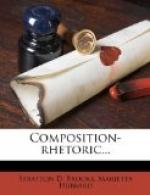+34. Cautions and Suggestions.+
1. Be careful not to use the apostrophe in the possessive forms its, yours, ours, and theirs.
2. Be careful to use the nominative form of a pronoun used as an attribute complement: [It is I; it is they].
3. Be sure that the pronoun agrees in number with its antecedent. One of the most common violations of this rule is in using their in such sentences as the following:—Every boy and girl must arrange his desk. Who has lost his book? The use of every and the form has obliges us to make the possessive pronouns singular.
His may be regarded as applying to females as well as males, where it is convenient not to use the expression his or her.
4. The so-called subject of an infinitive is always in the objective case: [I asked him to go].
5. The attribute complement will agree in case with the subject of the verb. Hence the attribute complement of an infinitive is in the objective case: [I knew it (obj.) to be him]; but the attribute complement of the subject of a finite verb is in the nominative case: [I knew it (nom.) was he].
6. Words should be so arranged in a sentence that there will be no doubt in the mind concerning the antecedent of the pronoun.
7. Do not use the personal pronoun form them for the adjective those: [Those books are mine].
+35. Compound Personal Pronouns.+—To the personal pronouns my, our, your, him, her, it, and them, the syllables self (singular) and selves (plural) may be added, thus forming what are termed compound personal pronouns. These pronouns have only two uses:—
1. They are used for emphasis: [He himself is an authority on the subject].
2. They are also used reflexively: [The boy injured himself].
+36. The Relative or Conjunctive Pronouns.+—The pronouns who, which, what (= that which), that, and as (after such) are more than equivalents for nouns, inasmuch as they serve as connectives. They are often named relative pronouns because they relate to some antecedent either expressed or implied; they are equally well named conjunctive pronouns because they are used as connectives. They introduce subordinate clauses only; these clauses are called relative clauses, and since they modify substantives, are also called adjective clauses.
+37. Uses of Relative Pronouns.+—Who is used to represent persons, and objects or ideas personified; which is used to represent things; that and as are used to represent both persons and things.
When a clause is used for the purpose of pointing out some particular person, object, or idea, it is usually introduced by that; but when the clause supplies an additional thought, who or which is more frequently used. The former is called a restrictive clause, and the latter, a non-restrictive clause.




